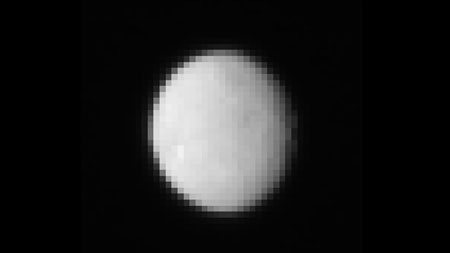| Jan 20, 2015 |
Dawn - heading for icy Ceres
|
|
(Nanowerk News) Planetary scientists at the German Aerospace Center (Deutsches Zentrum für Luft- und Raumfahrt; DLR) may find a thick ice crust with an ocean underneath when the NASA Dawn spacecraft arrives at Ceres in March 2015. Even now, from a distance of 383,000 kilometres, the first surface features are visible. Images acquired by the German-developed Framing Camera on 13 January 2015 reveal significantly lighter and darker areas on the near-spherical dwarf planet.
|
|
"Ceres is still an unknown celestial body but these first images hint that the surface has structures such as impact craters and fissures," says Ralf Jaumann of the DLR Institute of Planetary Research and a scientist on the Dawn mission team.
|
|
In late January, the images from the Framing Camera will achieve a resolution that surpasses that of the best images acquired by the Hubble Space Telescope.
|
 |
| View of Ceres from 383,000 kilometers.
|
|
First visit to a dwarf planet
|
|
The next goal of the Dawn mission, which it will reach in March 2015, lies in the asteroid belt, where sunlight is limited and water can exist as ice. When Dawn visited the asteroid Vesta in 2011, it encountered and studied a 'dry', rocky asteroid; now, Dawn will examine the complete opposite – Ceres is a 'wet' asteroid, likely to have water content of between 15 and 25 percent. In 2006, the International Astronomical Union (IAU) 'promoted' Ceres to a dwarf planet; its nearly 1000-kilometre-diameter and round shape suggest that it could just have failed to become a regular planet when the Solar System formed, and could be representative of an intermediate stage of particular interest to planetary scientists looking into the past.
|
|
"With Dawn, we are studying a dwarf planet for the first time," says Jaumann.
|
|
Dawn will spend 16 months analysing the surface of Ceres from various altitudes and the Framing Camera will acquire images autonomously. From the data, a three-dimensional terrain model of Ceres will be computed at the DLR Institute of Planetary Research; the celestial body will be mapped and its topography analysed. These three-dimensional measurements allow scientists to draw conclusions about, for example, the force of the impacts that formed craters. Under the icy crust of Ceres, researchers suspect there is a 100-metre-thick layer of water in which there might be traces of simple life forms.
|
|
"The Dawn spacecraft will further investigate this icy body in the coming months and we will uncover one or more scientific surprises," predicts Jaumann.
|
|
The Dawn mission
|
|
NASA's Jet Propulsion Laboratory (JPL) in Pasadena manages the Dawn mission; JPL is a division of the California Institute of Technology. The University of California, Los Angeles, is responsible for overall Dawn mission science. The camera system on the spacecraft was developed and built under the leadership of the Max Planck Institute for Solar System Research in Göttingen, Germany, in collaboration with the DLR Institute of Planetary Research in Berlin and the Institute of Computer and Communication Network Engineering in Braunschweig. The Framing Camera project is funded by the Max Planck Society, DLR, and NASA/JPL.
|

